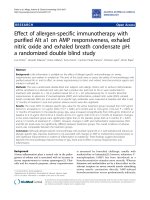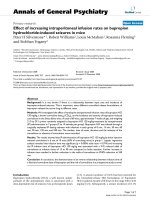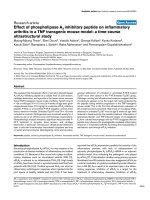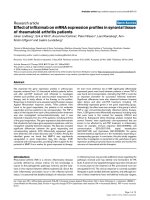Báo cáo y học: "Effect of hemofiltration filter adsorption on circulating IL-6 levels in septic rats" pps
Bạn đang xem bản rút gọn của tài liệu. Xem và tải ngay bản đầy đủ của tài liệu tại đây (54.63 KB, 5 trang )
Available online />Research
Effect of hemofiltration filter adsorption on circulating IL-6 levels
in septic rats
John A Kellum
1
and Michael K Dishart
2
1
Associate Professor of Critical Care Medicine and Medicine, Department of Critical Care Medicine, University of Pittsburgh Medical Center, PA, USA
2
Section Head, Critical Care, Department of Anesthesiology, Western Pennsylvania Hospital, Pittsburgh, PA, USA
Correspondence: John A Kellum,
Introduction
Numerous studies have shown that hemofiltration using
porous synthetic membranes can and does remove a wide
range of substances that mediate inflammation from the
plasma [1–2]. Limited evidence supports the notion that this
treatment can also influence circulating plasma concentrations
of various mediators [3–5] and mounting evidence suggests
that these manipulations have important biologic effects [6–8].
Despite these advances, there are no randomized clinical trials
demonstrating that hemofiltration improves outcome in
patients with sepsis. Furthermore, the exact mechanisms
responsible for immunomodulation with hemofiltration remain
uncertain. Modern hemofiltration filters may adsorb mediator
substances as well as permitting them to pass through the
membrane. Determining which of these mechanisms is domi-
nant will be essential to advancing the design of materials and
methodology suited to this form of therapy. If adsorption is the
primary effect, the surface area of the filters must be
ANOVA = one-way analysis of variance; AUC = area under the curve; CLP = cecal ligation and puncture; ELISA = enzyme-linked immunosorbent
assay; IL = interleukin; SNK = Student–Newman–Keuls; TNF = tumor necrosis factor.
Abstract
Introduction Hemofiltration may modulate the inflammatory response in sepsis through a variety of
mechanisms. We sought to distinguish clearance from adsorption as the principal mechanism
responsible for reducing circulating IL-6 levels with hemofiltration.
Materials and methods Nine hours after cecal ligation and puncture in 18 adult male Sprague–
Dawley rats, we divided the rats into three groups (6 animals each) and placed groups 2 and 3 on a
hemofiltration circuit connected between the right carotid artery and femoral vein using an AN69
membrane. In the hemofiltration group (group 2), ultrafiltrate was replaced with lactated Ringer’s
solution; in the recirculation group (group 3), the ultrafiltrate was reinfused into the animal. A sham
group (group 1) had an arteriovenous circuit inserted but no hemofiltration. Blood was obtained for
measurement of IL-6 and tumor necrosis factor (TNF) at the start of hemofiltration and after 5 and
11 hours of treatment.
Results and discussion IL-6 levels increased only in the sham-treated animals (20.4 ± 11.3 at
baseline to 62.3 ± 16.8 pg/ml at 11 hours, P = 0.03) (differences between groups 1 and 2, P = 0.015,
and groups 1 and 3, P = 0.028). TNF levels were highly variable but not significantly different among
the three groups.
Conclusion Hemofiltration-associated reductions in circulating IL-6 levels appear to be secondary to
adsorption of mediators to the filter membrane. We do not know whether this is due to direct adsorption
of IL-6 per se or to the absorption of other mediators with secondary downregulation of IL-6 production
or release. In addition, we could not exclude an interaction between adsorption and hemofiltration.
Keywords continuous renal replacement therapy, cytokines, hemofiltration, interleukins, sepsis, tumor necrosis factor
Received: 9 January 2002
Revisions requested: 17 February 2002
Revisions received: 23 May 2002
Accepted: 27 May 2002
Published: 19 June 2002
Critical Care 2002, 6:429-433
This article is online at />© 2002 Kellum and Dishart, licensee BioMed Central Ltd
(Print ISSN 1364-8535; Online ISSN 1466-609X)
Critical Care October 2002 Vol 6 No 5 Kellum and Dishart
increased, perhaps by using beads rather than filaments. Con-
versely, if mediator substances are removed mainly by sieving,
increases in ultrafiltration rates will be required.
We undertook these experiments to determine whether
adsorption alone could affect the inflammatory state of rats
with sepsis in a manner similar to standard hemofiltration. We
chose to measure interleukin-6 (IL-6) as a marker of the acti-
vation status of the cytokine network because it is known to
persist for several hours in the circulation and reflects the
influences of several other cytokines [9–10]. Although IL-6 is
not cytotoxic, circulating IL-6 is reproducibly detectable in
patients with sepsis, and higher concentrations portend a
poor outcome [11]. For these reasons, IL-6 has increasingly
been used a marker of the inflammatory response in clinical
trials of investigational agents in sepsis [12]. We also mea-
sured tumor necrosis factor (TNF) in an effort to correlate
changes in IL-6 with TNF activity during the same period.
Materials and methods
Surgical preparation
After approval by the Animal Care and Use Committee of the
University of Pittsburgh Medical Center, we anesthetized 20
adult, male Sprague–Dawley rats (mean weight 486 g) with
pentobarbital sodium (50 mg/kg intraperitoneally). We per-
formed a midline laparotomy, exteriorized the cecum, and
placed a ligature inferior to the ileocecal valve using 4-0 silk.
We punctured the cecum three times using a sterile 18-
gauge needle, placing one puncture site on each of the three
antimesenteric surfaces. We then returned the cecum to the
abdominal cavity and closed with 2-0 suture. We then admin-
istered a subcutaneous bolus of saline (50 ml/kg) as fluid
resuscitation and returned the animals to their cages and
allowed food and water ad libitum. In two animals, we
obtained serial blood samples each hour for 24 hours and
measured IL-6 and TNF concentrations. The results from
these animals were used to plan the experiments for the
remaining groups. We randomized the remaining 18 rats into
three groups. Seven hours after the cecal ligation and punc-
ture (CLP), we reanesthetized each animal and intubated it
with a beveled, 16-gauge angiocatheter and ventilated it with
room air using a Harvard rodent ventilator (Holliston, MA,
USA) at a tidal volume of 10 ml/kg and a frequency sufficient
to maintain an arterial PCO
2
between 35 and 45 mmHg. We
isolated the right carotid artery and the left femoral vein by
dissection and cannulated each with 1.27-mm PE-90 tubing.
The tubing was formed into a catheter by inserting a beveled
20-gauge needle into one end. We flushed each cannula with
heparinized saline (2000 units/liter). We placed a 3-way stop-
cock on each catheter so that blood sampling could be
achieved using the carotid arterial catheter and fluid could be
administered through the venous catheter.
Experimental procedure
Nine hours after CLP, we connected the arterial and venous
catheters for animals in groups 2 and 3 to a clamped hemo-
filter with an AN-69 membrane (Miniflow-10, Hospal, Lyon,
France), surface area = 0.042 m
2
, fiber internal diameter
240 µm, fiber wall thickness 50 µm. The filter, which had
been flushed with sterile saline only, was flushed with
5000 unit/liter heparinized saline immediately before the
circuit was opened.
For animals in group 1, we connected the arterial and venous
cannulas to each other and we removed 3 ml of blood to
control for the deadspace of the filter, and replaced this
volume with heparinized saline. The circuits were driven by
the arterial blood pressure. The replacement fluid consisted
of the following: 1:1 replacement of blood with 6% Het-
astarch in saline, and 1:1 replacement of ultrafiltrate produc-
tion with lactated Ringer’s solution. We infused the lactated
Ringer’s solution as predilution into the arterial limb of the
hemofilter. We gave the Hetastarch through the catheter in
the femoral vein. We collected the ultrafiltrate and measured
it twice an hour to maintain an accurate replacement rate
(average 30 ml/hour). We began replacing the ultrafiltrate
after the first half-hour.
For animals in group 3, we reinfused ultrafiltrate as replace-
ment fluid. We chose to study reinfusion rather than ultrafil-
trate clamping because sieving may augment adsorption by
increasing the effective surface area of the membrane by
exposing more of the inner matrix of the filter to plasma.
Blood was drawn from all the animals at hours 9, 14 and 20.
The initial blood sample included blood for blood gas analysis
(1.0 ml total). All other blood samples were 0.75 ml. We mea-
sured the hemoglobin concentration and oxygen saturation in
each blood sample using an OSM3 Hemoximeter (Radiome-
ter America, Inc, Westlake, Ohio, USA) to ensure that the
animal was neither hypovolemic nor hypoxic. The blood
sample was divided into two 0.4-ml chilled tubes containing
EDTA (1 mg/ml) and centrifuged immediately at 1000 g for
10 minutes. The plasma was drawn off, placed into 0.5-ml
labeled microtubes and stored at –70°C for later cytokine
analysis. The animals remained anesthetized and on the venti-
lator until the 20th hour after the laparotomy, when we killed
them humanely.
Measurements and calculations
Plasma concentrations of IL-6 and TNF were determined by
rat-specific ELISA according to manufacturer instructions
(Biosource International, Camarillo, CA, USA, and Endogen,
Woburn, MA, USA), respectively. The TNF assay was linear
from 0 to 2500 pg/ml, and the IL-6 assay was linear from 0 to
2000 pg/ml; coefficients of variation on repeated samples
were less than 10% for both assays.
Our primary analysis was based on the change in IL-6 con-
centrations from the beginning to the end of the hemofiltra-
tion (9 hours versus 20 hours) across the three groups. The
absolute changes in IL-6 concentrations were compared
using one-way analysis of variance (ANOVA) followed by the
Student–Newman–Keuls (SNK) multiple comparison test.
Our secondary analysis of TNF concentrations was per-
formed after calculating the area under the curve (AUC)
formed by three measurements (at 9, 14 and 20 hours) and
zeroed by the baseline (9 hours) levels. Mean areas were
compared for each group using ANOVA/SNK analysis as per
IL-6 above. The absolute changes in IL-6 were correlated
across all groups with the TNF AUC, using linear regression.
All statistical tests were performed using MedCalc
®
(v 4.2,
Mariakerke, Belgium) software and statistical significance
was assumed for P < 0.05. Unless specified otherwise, all
results are presented as means ± standard deviation.
Results
In the two animals used for mapping IL-6 and TNF responses
to CLP, we found results consistent with those of other inves-
tigators [13]. Namely, plasma IL-6 concentrations rose
steadily, peaking between 18 and 20 hours after CLP,
whereas no consistent pattern emerged for plasma TNF
levels. The results for the three groups are shown in Table 1.
IL-6 levels were not significantly different among the three
groups at baseline and at 5 hours. However, IL-6 levels
increased in the sham-treated animals (group 1) from base-
line to 11 hours (see Table 1; P = 0.03) (differences between
groups 1 and 2, P = 0.015 and groups 1 and 3, P = 0.028)
(Fig. 1). TNF levels were highly variable between and within
animals. TNF AUC analysis was not significantly different
among the three groups, although the trend was in the same
direction as for IL-6, in that group 1 tended to have the
highest TNF concentrations (453 ± 509 pg/ml per 11 hours),
group 2 the lowest (160 ± 443 pg/ml per 11 hours) and
group 3 intermediate (359 ± 377 pg/ml per 11 hours). The
relation between the change in IL-6 and the TNF AUC is
shown in Fig. 2. The weak correlation between the two as
shown by linear regression was not statistically significant.
Discussion and conclusion
Our findings show that the inflammatory response induced by
CLP and characterized by a steady increase in circulating IL-6
levels over 18–24 hours can be inhibited to a similar degree
by hemofiltration whether or not the ultrafiltrate is reinfused.
These findings provide strong evidence that immunomodula-
tion seen with hemofiltration is predominantly the result of
adsorption of circulating mediator substances to the filter
membrane. Future studies of hemofiltration in sepsis might be
more successful if steps are taken to maximize adsorption.
Our findings also confirm those of our previous trial in
humans [3] and work from other groups [4–5] showing that
biologically significant immunomodulation can and does
occur with continuous hemofiltration. However, the clinical
significance of these changes remain in question. Unlike ther-
apies designed to target specific mediators, hemofiltration
has the theoretical advantage of being at once selective and
nonspecific [14]. Hemofiltration is selective in the sense that
it will affect circulating substances in direct proportion to their
concentrations in the plasma, but nonspecific in that it will
remove multiple substances, both proinflammatory and anti-
inflammatory [1–2]. This feature makes hemofiltration quite
different from other forms of immunomodulation that target
specific mediators and reduce their concentration regardless
of the baseline levels.
Hemofiltration has been shown remove a wide variety of bio-
logically active substances, many of which are known to be
involved in the regulation of host defense, inflammation and
Available online />Figure 1
Plasma IL-6 concentrations in rats before (light bars) and after (dark
bars) 11 hours of hemofiltration started 9 hours after cecal ligation and
puncture (CLP). Animals in group 1 underwent CLP with sham
hemofiltration. Animals in group 2 underwent CLP and hemofiltration.
Animals in group 3 underwent CLP and hemofiltration with reinfusion
of the ultrafiltrate intravenously. Heights of bars correspond to mean
IL-6 levels; error bars = SEM. Significant differences were found for
group 1 before versus after, and after hemofiltration between groups 1
and 2 and 1 and 3 (P < 0.05). SEM, standard error of the mean.
0
10
20
30
40
50
60
70
80
Group 1 Group 2 Group 3
IL-6 (pg/ml)
Figure 2
Scatter plot of tumor necrosis factor area-under-the-curve (TNF AUC)
versus the change in IL-6 before and after hemofiltration in rats that
had undergone cecal ligation and puncture. The regression line was
determined by linear regression (y = 0.0289x + 2.1158), r = 0.3217
(95% confidence interval for r = –0.1709 to 0.6856).
-40
-20
0
20
40
60
80
100
120
140
-500 0 500 1000 1500
TNF AUC
Delta IL-6 pg/ml
tissue repair. However, controversy exists as to the primary
mechanism responsible for this effect. We have previously
shown, in patients with sepsis, that time-weighted mean TNF
concentrations decreased during continuous venovenous
hemofiltration but increased if the same patients were treated
with continuous venovenous hemodialysis [3]. Despite these
changes in circulating TNF levels, only trace amounts of TNF
were recovered from the ultrafiltrate. Subsequently, other
groups have found similar results in patients treated with con-
tinuous venovenous hemofiltration on cardiopulmonary
bypass [4] or in patients with septic shock [5]. However, both
of these recent studies showed only early, transient reduc-
tions in plasma cytokines, suggesting that filter saturation
occurs after several hours of therapy. The various membranes
currently available differ significantly from one another in their
adsorptive capacity for mediators [15]. Indeed, the majority of
studies of hemofiltration in sepsis have failed to find any
change in circulating mediator concentrations. These obser-
vations have led to the development of combined hemofiltra-
tion/hemoadsorption techniques, which are beginning to
show promise in animal studies [16].
Our results do not exclude a possible role for mechanisms
other than adsorption. Several investigators have found an
association between increased ultrafiltration rates and
improvement in hemodynamic stability in both animals and
humans with septic shock [5–8]. It may be that these
improvements in hemodynamic stability do not involve
cytokine removal. Furthermore, filtration appears to augment
adsorption [3], so that combined filtration/adsorption might
be more effective than adsorption alone, at least when
hollow-fiber dialyzers are used. Other methods of increasing
adsorption might be even more effective [17].
A major limitation to our study is the fact that we cannot dis-
tinguish between increased IL-6 removal and decreased IL-6
production as the cause for the observed attenuation in IL-6
response to CLP. We chose to use IL-6 as our marker of the
inflammatory response because, unlike many other cytokines,
its plasma concentrations have been directly correlated with
risk of death in intra-abdominal sepsis in humans, and mea-
surements of this single parameter predicted outcome in
these cases with remarkable (82.9%) accuracy [18]. Further-
more, although IL-6 is not directly cytotoxic, there is evidence
that it modulates other inflammatory cytokines [19–20], and
plasma concentrations have been found to be 69% (95%
confidence interval 30%–108%) higher in nonsurvivors than
in survivors with sepsis [9]. Many studies have shown an
association between mean plasma IL-6 concentrations over
time and mortality [21], and persistent elevations in IL-6
appear to be more important than initial or peak levels [10].
However, plasma IL-6 levels reflect both clearance (endoge-
nous and exogenous) and production, and IL-6 production is
largely determined by the activity of other proinflammatory
cytokines (especially IL-1 and TNF).
Thus, hemofiltration may attenuate the sepsis-induced rise in
IL-6 by adsorption of IL-6 or by adsorption of other mediators
or both. Indeed, it seems likely that our findings resulted from
a downregulation in the inflammatory response to CLP. This
explanation is speculative, however, because we could not
demonstrate a corresponding decrease in plasma TNF.
Analysis of plasma TNF concentrations is more complex than
of IL-6, because the TNF response is already waning by 9
hours after CLP [22] and is much more variable. Furthermore,
Critical Care October 2002 Vol 6 No 5 Kellum and Dishart
Key messages
• Changes in IL-6 seen with hemofiltration are
predominantly the result of adsorption of circulating
inflammatory mediator substances to the filter
membrane
• Biologically significant immunomodulation can and
does occur with continuous hemofiltration at blood
flow rates currently in use in clinical practice
• We cannot distinguish between increased IL-6 removal
and decreased IL-6 production as the cause for the
attenuation in the IL-6 response to sepsis observed
with hemofiltration
• Future studies of hemofiltration in sepsis might be more
successful if steps are taken to maximize adsorption
Table 1
Cytokine concentrations (pg/ml; mean ± SEM) found in rats after cecal ligation and puncture followed by hemofiltration
Group 1
a
Group 2
b
Group 3
c
Time (h) IL-6 TNF IL-6 TNF IL-6 TNF
0 20.4 ± 11.3 7.6 ± 7.6 29.9 ± 8.9 65.7 ± 23.7 14.7 ± 8.6 41.1 ± 22.4
5 32.1 ± 8.9 54.7 ± 23.8 34.4 ± 10.1 105.2 ± 36.6 21.1 ± 11.2 79.3 ± 25.6
11 62.3 ± 16.8* 63.1 ± 23.0* 17.1 ± 6.3
#
49.3 ± 18.2 20.2 ± 9.9
#
83.6 ± 29.8*
a
Sham group: arteriovenous circuit inserted but no hemofiltration.
b
Ultrafiltrate replaced with lactated Ringer’s solution.
c
Ultrafiltrate reinfused into
the animal. *P < 0.05 in comparison with baseline (0 h).
#
P < 0.05 in comparison with group 1. SEM, standard error of the mean; TNF, tumor
necrosis factor.
we measured total TNF and do not know the proportion that
was biologically active at the time. We chose to analyze TNF
using AUC because of these concerns and because the
effects of TNF over time presumably relate to outcome and to
IL-6 expression more than to a concentration at a single time
point. Unfortunately, the smallness of the animals precluded
multiple sampling and we selected only three time points in
order to obtain the ‘curve’ used for AUC analysis. These limi-
tations and the small sample size perhaps explain why we
were only able to show a weak correlation between TNF AUC
and changes in IL-6 concentrations over time.
Finally, we must acknowledge that our animal model of
sepsis, like sepsis in humans, is associated with a variable
inflammatory response (Table 1). However, both absolute and
relative changes in IL-6 levels appear similar with hemofiltra-
tion with or without recirculation of ultrafiltrate. These results
suggest that adsorption is the primary, though perhaps not
the sole, mechanism responsible for changes in IL-6 levels
during hemofiltration.
Competing interests
None declared.
Acknowledgement
The authors thank Laurie A Vergato, MA, and Jeffery Schmigel, BS, for
their technical assistance. Support for this project was provided by a
grant from the Laerdal Foundation for Acute Medicine.
References
1. Bellomo R: Continuous hemofiltration as blood purification in
sepsis. New Horizons 1995, 3:732-737.
2. Kellum JA: Immunomodulation in sepsis: the role of hemofil-
tration. Minerva Anestesiol 1999, 65:410-418.
3. Kellum JA, Johnson JP, Kramer D, Palevsky P, Brady JJ, Pinsky
MR: Diffusive vs. convective therapy: effects on mediators of
inflammation in patient with severe systemic inflammatory
response syndrome. Crit Care Med 1998, 26:1995-2000.
4. Tassani P, Richter JA, Eising GP, Barankay A, Braun SL, Haehnel
CH, Spaeth P, Schad H, Meisner H: Influence of combined
zero-balanced and modified ultrafiltration on the systemic
inflammatory response during coronary artery bypass graft-
ing. J Cardiothorac Vasc Anesth 1999, 13:285-291.
5. De Vriese AS, Colardyn FA, Philippe JJ, Vanholder RC, De Sutter
JH, Lameire NH: Cytokine removal during continuous hemofil-
tration in septic patients. J Am Soc Nephrol 1999, 10:846-853.
6. Lee PA, Matson JR, Pryor RW, Hinshaw LB: Continuous arterio-
venous hemofiltration therapy for Staphylococcus aureus-
induced septicemia in immature swine. Crit Care Med 1993,
21:914-924.
7. Bellomo R, Kellum JA, Gandhi CR, Pinsky MR, Ondulik B: The
effect of intensive plasma water exchange by hemofiltration
on hemodynamics and soluble mediators in canine endotox-
emia. Am J Respir Crit Care Med 2000, 161:1429-1436.
8. Honore PM, Jamez J, Wauthier M, Lee PA, Dugernier T, Pirenne B,
Hanique G, Matson JR: Prospective evaluation of short-term,
high-volume isovolemic hemofiltration on the hemodynamic
course and outcome in patients with intractable circulatory
failure resulting from septic shock. Crit Care Med 2000, 28:
3581-3587.
9. Casey LC, Balk RA, Bone RC: Plasma cytokine and endotoxin
levels correlate with survival in patients with the sepsis syn-
drome. Ann Intern Med 1993, 119:771-778.
10. Pinsky MR, Vincent JL, Deviere J, Alegre M, Khan RJ, Dupont E:
Serum cytokine levels in human septic shock: relation to mul-
tiple-system organ failure and mortality. Chest 1993, 103:565-
575.
11. Calandra T, Gerain J, Heumann D, Baumgartner JD, Glauser MP:
High circulating levels of interleukin-6 in patients with septic
shock: evolution during sepsis, prognostic value, and inter-
play with other cytokines. Am J Med 1991, 91:23-29.
12. Bernard GR, Vincent JL, Laterre PF, LaRosa SP, Dhainaut JF,
Lopez-Rodriguez A, Steingrub JS, Garber GE, Helterbrand JD, Ely
EW, Fisher CJ Jr, for the PROWESS Study Group: Efficacy and
safety of recombinant human activated protein C for severe
sepsis. N Engl J Med 2001, 344:699-709.
13. Andrejko KM, Chen J, Deutschman CS: Intrahepatic STAT-3
activation and acute phase gene expression predict outcome
after CLP sepsis in the rat. Am J Physiol 1998, 275:G1423-
G1429.
14. Kellum JA, Bellomo R: Hemofiltration in sepsis: where do we
go from here? Crit Care 2000, 4:69-71.
15. Lonnemann G, Koch KM, Shaldon S, Dinarello CA: Studies on
the ability of hemodialysis membranes to induce, bind and
clear human interleukin-1. J Lab Clin Med 1988, 112:76-86.
16. Tetta C, Gianotti L, Cavaillon JM, Wratten ML, Fini M, Braga M,
Bisagni P, Giavaresi G, Bolzani R, Giardino R: Coupled plasma
filtration-adsorption in a rabbit model of endotoxic shock. Crit
Care Med 2000, 28:1526-1533.
17. Kellum JA, Song M, Venkataraman R, Schmigel J, Statile C:
Improved survival with hemoadsorption in endotoxin-induced
shock in rats [abstract]. Am J Respir Crit Care Med 2002, 165:
A176.
18. Patel RT, Deen KL, Youngs D, Warwick J, Keighley MR: Inter-
leukin 6 is a prognostic indicator of outcome in severe intra-
abdominal sepsis. Brit J Surg 1994, 81:1306-1308.
19. Frode TS, Souza GE, Calixto JB: The effects of IL-6 and IL-10
and their specific antibodies in the acute inflammatory
responses induced by carrageenan in the mouse model of
pleurisy. Cytokine 2002, 17:149-156.
20. Hallbeck AL, Walz TM, Wasteson A: Interleukin-6 enhances
transforming growth factor-alpha mRNA expression in
macrophage-like human monocytoid (U-937-1) cells. Biosci
Rep 2001, 21:325-339.
21. Barriere SL, Lowry SF: An overview of mortality risk prediction
in sepsis. Crit Care Med 1995, 23:376-393.
22. Ertel W, Morrison MH, Wang P, Ba ZF, Ayala A, Chaudry IH: The
complex pattern of cytokines in sepsis. Association between
prostaglandins, cachectin, and interleukins. Ann Surg 1991,
214:141-148.
Available online />

![Báo cáo Y học: Effect of adenosine 5¢-[b,c-imido]triphosphate on myosin head domain movements Saturation transfer EPR measurements without low-power phase setting ppt](https://media.store123doc.com/images/document/14/rc/vd/medium_vdd1395606111.jpg)







